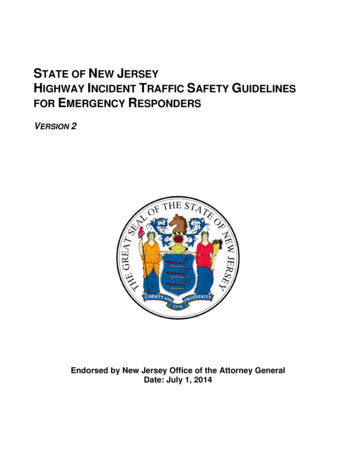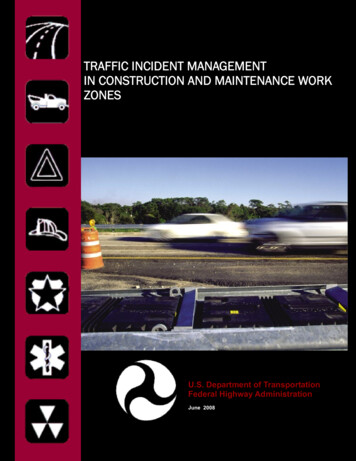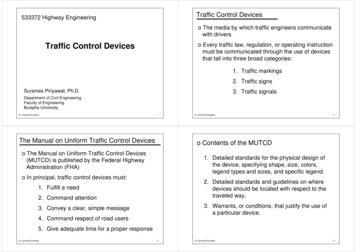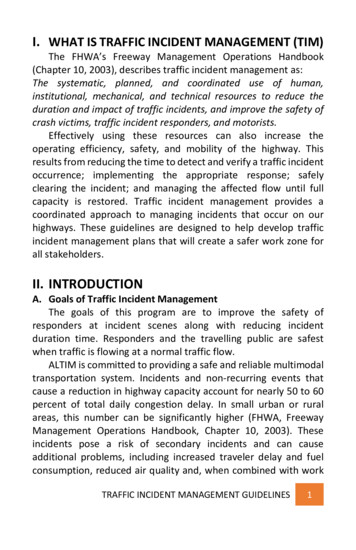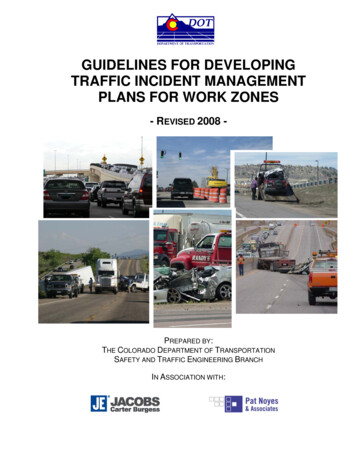
Transcription
GUIDELINES FOR DEVELOPINGTRAFFIC INCIDENT MANAGEMENTPLANS FOR WORK ZONES- REVISED 2008 -PREPARED BY:THE COLORADO DEPARTMENT OF TRANSPORTATIONSAFETY AND TRAFFIC ENGINEERING BRANCHIN ASSOCIATION WITH:
Guidelines for Traffic Incident Management in Work Zones (2008)Page 1Table of ContentsLIST OF TABLES . 3List of Figures .3I. HISTORY / BACKGROUND . 4Federal Requirements for Work Zones and Traffic Incident Management .4National Incident Management System (NIMS) .4National Unified Goal for Traffic Incident Management .6Background Material.6II. INTRODUCTION . 7Goals of Traffic Incident Management for Work Zones.7Best Practices .8Overview of Existing CDOT TIMPs .10North I-25 – Weld/Larimer Counties .10US 36 – I-25 to Boulder .10I-25 – Express Lanes.10T-REX – I-25 Broadway to Lincoln Avenue, I-225 Parkway to I-25 .10South I-25 – Douglas County .10DIA – I-225/I-70 Interchange .116th Avenue – Kalamath to I-70 .11I-70 Mountain Corridor – Morrison to Utah .11I-25 El Paso County.11Pueblo County .11I-25 Trinidad .11Park County Highway Incident Management Program.11III. CONSIDERATIONS FOR DEVELOPING TRAFFIC INCIDENTMANAGEMENT PLANS . 12Incorporating and Adapting Existing Programs .12Identifying Appropriate Program Detail .12Coordinating with Stakeholders .14Agency Identification .15Coordination with Other Projects .16ITS Considerations .17
Guidelines for Traffic Incident Management in Work Zones (2008)Page 2Response Manual.17IV. THE PLANNING PROCESS. 18Process Overview .19Planning Overview .20Goals .20Objectives.20Performance Measures .20Strategies and Tactics .20Program Implementation .20Program Evaluation .20Multi-disciplinary Approach .20Alternative Strategies .21Construction Phasing and Method of Handling Traffic .22V. KEY COMPONENTS OF A TRAFFIC INCIDENT MANAGEMENTPROGRAM. 23Response Agencies .23Roles and Responsibilities .23Agency Roles .23Response Area Boundaries.24Existing Protocols and Agreements.25Contact Information .25Contact Procedures.26Incident Levels .26Incident Level Definitions.26Associated Actions .27“Move-it Law” and Accident Alert .29Application to Project Area .29Procedural Guidelines for Scene Management.29Reporting Incidents.29Application of the National Incident Management System and Incident CommandSystem.30Moving Vehicles .33Emergency Traffic Control .33Use of Emergency Flashers .35Apparatus Parking and Staging .36Dedicated Response Teams .37Dedicated Response Equipment .37Communication/Interoperability .38Emergency Access .39
Guidelines for Traffic Incident Management in Work Zones (2008)Page 3Accident Investigation Sites .40Resource Management .40Traveler Information .41Procedures for Informing Drivers.42Public Information Activities.42Procedures for Working with the Media.44VI. PREPAREDNESS . 46Training and Exercises.46VII. ONGOING MANAGEMENT AND MAINTENANCE. 47After Action Reviews .47Evaluation and Updates .48Performance Measures.49APPENDIX A: SAMPLE STRATEGY MATRIX . 50APPENDIX B: PROCEDURAL DIRECTIVE 1510.1 . 56APPENDIX C: REFERENCES . 60APPENDIX D: LIST OF ACRONYMS. 61List of TablesTable 1: Examples of Work Zone Traffic Incident Management .8List of FiguresFigure 1: Flowchart for Developing a TIMP for Work Zones .13Figure 2: Steps in Developing a TIM Program .19
Guidelines for Traffic Incident Management in Work Zones (2008)Page 4I. HISTORY / BACKGROUNDFederal Requirements for Work Zones and Traffic IncidentManagement23 CFR Part 630 addresses Work Zone Safety and Mobility (WZSM). It states:The FHWA recognizes that increasing road construction activity on our highwayscan lead to an increase in congestion and crashes, as well as loss in productivityand public frustration with work zones. [Changes to 23 CFR Part 630 were]intended to facilitate consideration of the broader safety and mobility impacts ofwork zones in a more coordinated and comprehensive manner across projectdevelopment stages.(Federal Register, Vol. 68, No. 88, May 7, 2003, page 24385)23 CFR Part 630 requires the development of a Transportation Management Plan (TMP)for each highway project. One component of the TMP is the Transportation OperationsPlan (TOP).A TOP includes considerations that address the safety and mobility of thetransportation system by adopting strategies for the sustained operations andmanagement of the work zone impact area. The TOP consists of strategies thataddress transportation systems management; corridor management; and trafficmanagement operations and safety (i.e., Intelligent Transportation Systems (ITS)based traffic control and traveler information, speed management andenforcement, incident and emergency management, safety reviews and audits).Development and sustained coordination of the TOP in partnership withstakeholders (i.e., other transportation agencies, transit providers, freight movers,utility suppliers, police, fire, emergency medical services, and regionaltransportation centers) is encouraged.(Federal Register, Vol. 68, No. 88, May 7, 2003, page 24403)Chapter 6 of the Manual on Uniform Traffic Control Devices (MUTCD) states “Theprimary function of [Temporary Traffic Control] TTC is to provide for the reasonably safeand efficient movement of road users through or around TTC zones while reasonablyprotecting workers, responders to traffic incidents, and equipment.” Chapter 6 includesrequirements and guidance on all temporary traffic control associated with work zonesand the traffic incidents. One of the principles for temporary traffic control is to develop“general plans or guidelines to provide safety for motorists, bicyclists, pedestrians,workers, enforcement/emergency officials, and equipment.National Incident Management System (NIMS)“On February 28, 2003, the President issued Homeland Security Presidential Directive(HSPD)–5, Management of Domestic Incidents, which directs the Secretary ofHomeland Security to develop and administer a National Incident Management System(NIMS). This system provides a consistent nationwide template to enable Federal,State, local, and tribal governments and private-sector and nongovernmentalorganizations to work together effectively and efficiently to prepare for, prevent, respondto, and recover from domestic incidents, regardless of cause, size, or complexity,including acts of catastrophic terrorism. This document establishes the basic elements of
Guidelines for Traffic Incident Management in Work Zones (2008)Page 5the NIMS and provides mechanisms for the further development and refinement ofsupporting national standards, guidelines, protocols, systems, and technologies.“Building on the foundation provided by existing incident management and emergencyresponse systems used by jurisdictions and functional disciplines at all levels, thisdocument integrates best practices that have proven effective over the years into acomprehensive framework for use by incident management organizations in an allhazards context (terrorist attacks, natural disasters, and other emergencies) nationwide.It also sets in motion the mechanisms necessary to leverage new technologies andadopt new approaches that will enable continuous refinement of the NIMS over time.This document was developed through a collaborative, intergovernmental partnershipwith significant input from the incident management functional disciplines, the privatesector, and nongovernmental organizations.“The NIMS represents a core set of doctrine, concepts, principles, terminology, andorganizational processes to enable effective, efficient, and collaborative incidentmanagement at all levels. It is not an operational incident management or resourceallocation plan HSPD-5 requires all Federal departments and agencies to adopt theNIMS and to use it in their individual domestic incident management and emergencyprevention, preparedness, response, recovery, and mitigation programs and activities,as well as in support of all actions taken to assist State, local, or tribal entities. Thedirective also requires Federal departments and agencies to make adoption of the NIMSby State and local organizations a condition for Federal preparedness assistance(through grants, contracts, and other activities) beginning in FY 2005.”National Incident Management System, U.S. Department of Homeland Security, March1, 2004.CDOT is integrating NIMS into its emergency and incident management programs.Major components of NIMS include: Command and management: Incident Command System (ICS), Multi-agencyCoordination Systems (MACS), and Public Information Systems. Preparedness: Planning, training, exercises, personnel qualification andcertification, and mutual aid. Resource management: Standardized mechanisms and process requirements todescribe, inventory, mobilize, dispatch, track and recover resources. Communications and information management:communications and information management. Supporting technologies: Creation and advancement of supporting technologythat provides capabilities essential for implementation and refinement. Ongoing management and maintenance: Routine review and continuousrefinement of the system and its components over the long term.Incidentmanagement
Guidelines for Traffic Incident Management in Work Zones (2008)Page 6Each of these is considered and addressed in the development and on-goingmanagement of incident management programs in the State of Colorado.National Unified Goal for Traffic Incident ManagementThe National Traffic Incident Management Coalition (NTIMC) is an official association oforganizations representing transportation professionals and emergency responders. TheNTIMC consists of national organizations representing emergency medical services, fire& rescue, law enforcement (local and state), public safety communications, towing andrecovery, and transportation departments.The goal of NTIMC is to promote and support the successful development of local,regional and statewide incident management programs through peer networking andknowledge.Information and resources to develop and support traffic incidentmanagement activities can be found on the NTIMC website (www.timcoalition.org).In 2007, the NTIMC announced a National Unified Goal (NUG) for incident management.The NUG was developed through a consensus process and was formally ratified inNovember 2007 by the NTIMC.The NUG promotes achievement of these objectives through 18 strategies, includingdevelopment of multi-jurisdictional, multi-disciplinary incident management policies,procedures and training, and development of national, multi-disciplinary recommendedpractices for operational issues. The NUG is organized around three major objectives: Responder safetySafe and quick clearancePrompt and reliable incident communicationsBackground MaterialAdditional background and reference materials are provided in Appendix C. The TrafficIncident Management Handbook, prepared for FHWA’s Office of Travel Management,includes information beyond what is presented in this manual and should be consultedfor further guidance. Other references included in Appendix C provide more detailedinformation than presented here.
Guidelines for Traffic Incident Management in Work Zones (2008)Page 7II. INTRODUCTIONGoals of Traffic Incident Management for Work ZonesCDOT is committed to providing the best, safest and most reliable multimodaltransportation system. In 2006, the U.S. Department of Transportation and NationalHighway Traffic Safety Administration published the Traffic Safety Facts 2005Publication (No. DOT HS 810 631, Washington, D.C., 2006). The report states that thenumber of fatalities which resulted from motor vehicle crashes in work zones hasincreased at an alarming rate from 1997 to 2005. In addition, it states that more than41,000 people were injured in 2003, as a result of motor vehicle crashes in work zones.This has grown from 36,000 in 1996. There were 1,074 fatalities in 2005, 1,028 fatalitiesin 2003, and 693 fatalities in 1997.Incidents and non-recurring events that cause a reduction in highway capacity accountfor nearly 50 to 60 percent of total daily congestion delay. In small urban or rural areas,this number can be significantly higher (FHWA, Freeway Management OperationsHandbook, Chapter 10, 2003). These incidents pose a risk of secondary incidents andcan cause additional problems, including increased traveler delay and fuel consumption,reduced air quality and, when combined with work zones, delays and costs to theconstruction project. Recent studies indicate that approximately 50 percent of allhighway congestion is attributed to non-recurring conditions (such as traffic incidents,weather, work zones, and special events), with work zones on freeways accounting fornearly 24 percent of all non-recurring delays. (U.S. Department of Energy, TemporaryLosses of Highway Capacity and Impacts on Performance, Oak Ridge NationalLaboratory (ORNL/TM-2002/3), May 2002.)Struck-by incidents, where passing motorists hit responders, are also on the rise. In2005, the National Institute for Occupational Safety and Health (NIOSH) reported that390 workers were killed in struck-by incidents (up from 278 in 2004). That year, struckby incidents accounted for 7 percent of the total number of occupational injuries. Dataon highway workers killed at traffic incidents currently is not separated from overallstatistics; however, NIOSH estimates struck-by deaths (including workers struck by apassing vehicle, or mobile equipment) accounted for half of the 844 worker deathsbetween 1996 and 2002. On average, at least two emergency responders are struckevery day in the United States. According to FBI statistics, between 1995 and 2006, anaverage of one U.S. law enforcement officer was struck and killed each month by apassing vehicle. In addition, about 20 percent of all firefighter deaths resulted fromvehicle-related incidents. In just the first three months of 2006, five Towing andRecovery Association of America towers were killed at traffic incident scenes.The FHWA’s Freeway Management Operations Handbook (Chapter 10, 2003),describes traffic incident management as:The systematic, planned, and coordinated use of human, institutional,mechanical, and technical resources to reduce the duration and impact of trafficincidents, and improve the safety of motorists, crash victims, and traffic incidentresponders. Effectively using these resources can also increase the operatingefficiency, safety, and mobility of the highway. This results from reducing thetime to detect and verify a traffic incident occurrence; implementing the
Guidelines for Traffic Incident Management in Work Zones (2008)Page 8appropriate response; safely clearing the incident; and managing the affectedflow until full capacity is restored.Traffic incident management provides a coordinated approach to managing incidentsthat occur on our highways. These guidelines are designed to help develop trafficincident management plans that will create a safer work zone for all stakeholders.Best PracticesCDOT’s initiative to provide guidelines for traffic incident management in work zonesbuilds on successful practices already in place in Colorado and other states. Although anumber of other states have adopted guidelines and requirements to address trafficincident management, CDOT’s effort goes beyond these current practices. Table 1illustrates practices from other states.Table 1: Examples of Work Zone Traffic Incident rthCarolinaDescriptionDesignated towing-serviceresponsible for keeping workzone free of disabled vehicles.Emergency traffic patrol fleetresponds to minor breakdownsand major incidents. Crashinvestigation sites are used toget vehicles off the roadwayduring investigation.Contractor provides 24-hour perday monitoring of traffic controldevices and incident responseand assists stranded motorists.I-55/I-20 reconstruction projectprovision outlined theresponsibilities of the contractoras part of the IncidentManagement Team, responsiblefor reducing traffic delay andproviding emergency vehicleaccess to the site.Since 1991, representativesfrom emergency responseagencies have met in IncidentManagement Inter-AgencyTeams. During team meetings,NCDOT resident engineersinform agencies aboutconstruction projects.BenefitQuick response results insignificant decrease in queuelengths and motorist delays.Helps to minimize the negativeeffects on traffic flow that resultfrom vehicle breakdowns andtraffic crashes.Improves traffic safety and trafficflow through majorreconstruction projects andprovides prompt notification ofincidents.The contractor became a partnerinvolved in making decisionswith the Incident ManagementTeam and was more willing tobe responsible for improvingtraffic control and emergencyvehicle access on the project.Pre-planning and preparationallow emergency responseagencies to access the scenemore quickly. Quick responseand clearance by predeterminedalternate routes help maintaintraffic flow.
Guidelines for Traffic Incident Management in Work Zones (2008)StateOregonDescriptionThe Westside Corridor WorkZone Incident Managementprogram included safe pulloutsfor disabled vehicles, tow truckand operator during peak hours,regular patrol by supervisor,supervisor truck with emergencyequipment, routine servicepatrols, call-in number formotorists to report incidents, andmotorist information providedthrough VMS and news outlets.Pennsylvania Incident management plans arerequired on long-termconstruction projects. The policyhas been in use since 1994 andrequires a pre-constructionmeeting with emergencyrespondersUtahService patrols were provided onthe I-15 project on I-15 and thealternate route I-215. Theservice patrols consisted ofvehicles equipped to handleminor vehicle problems.UtahUtah has initiated a cooperativeeffort of emergency responseagencies, trucking companiesand the media to developemergency response planssubmitted and incorporatedwithin traffic control plans.Page 9BenefitBenefits included reduced delayand enhanced safety in the workzone because incidents areresponded to and cleared faster.The program fostered good willwith the publicThe meetings eliminateguesswork during actualemergencies and provideeffective response and reduceddelay.The intended benefit was toreduce congestion and providegood public relations with thecommunity.The practice allows emergencyresponse agencies and theprivate sector to have input intothe overall traffic control plan,improving and coordinatingemergency response to the workzone.(Source: FHWA, Work Zone Operations Best Practices Guidebook, 2000)The California Department of Transportation “Transportation Management PlanGuidelines” (CalTrans Office of Systems Management Operations, May 2004) providesa list of traffic incident management strategies for consideration when developing TIMPsfor work zones. These strategies include: Call boxesEnhanced enforcementFreeway service patrolTraffic surveillance stations (traffic detectors and CCTV)911 cellular callsTransportation management centerTraffic control officersState police in TMC during constructionOnsite traffic advisor
Guidelines for Traffic Incident Management in Work Zones (2008) Page 10State police helicopterTraffic management teamThese strategies are in addition to those related to traveler information, alternate route,and public information that can be used during incidents.Overview of Existing CDOT TIMPsCDOT has led the development of a number of traffic incident management plans andprograms throughout the state. These programs address procedural and coordinationaspects of managing unplanned events on the highway that impact the flow of traffic.These incidents range from environmental events, to stalled vehicles, to multi-vehiclecrashes, to hazardous materials incidents that may impact the shoulder or close theentire roadway.Examples of formalized traffic incident management programs developed for long-termconstruction efforts in Colorado include the T-REX project in Denver and the COSMIXproject in Colorado Springs. These projects provided a program that integratedtransportation and public safety agencies in planning and responding to incidents in thework zone. They also provided coordination of traffic operation centers that monitoredand coordinated responses to incidents. Currently, there are twelve active trafficincident management programs for Colorado Interstates and State Highways. A briefdescription of the locations/areas of these programs is shown below. Additionalinformation for each program is available in the programs’ specific response manuals.North I-25 – Weld/Larimer CountiesThe North I-25 Weld/Larimer Counties Incident Management Plan developed by CDOTRegion 4 and covers I-25 from SH 7 (MP 229) to Exit 293.US 36 – I-25 to BoulderThe US 36 Incident Management Plan covers the Boulder Turnpike from I-25 to Boulder.I-25 – Express LanesThe I-25 HOV/Toll Lanes Traffic Incident Management Program covers both the ExpressLanes and general purpose lanes from 84th Avenue on I-25 and Pecos on US 36 intodowntown Denver at 20th Street.T-REX – I-25 Broadway to Lincoln Avenue, I-225 Parkway to I-25The T-REX Traffic Incident Management Program incorporated and updated the I-25DTC Incident Management Plan developed in 1998 and added additional sections of I25 and I-225. The limits of the T-REX program are I-25 from Broadway to LincolnAvenue and I-225 from Parker Road to I-25.South I-25 – Douglas CountyThe South I-25 Corridor Incident Management Program covers the 30 miles of I-25 inDouglas County (MP 193 to MP 163) and abuts the portion of I-25 covered in the T-REXTraffic Incident Management Program.
Guidelines for Traffic Incident Management in Work Zones (2008)Page 11DIA – I-225/I-70 InterchangeThe DIA Incident Management Plan was originally developed in 1997 and is currentlyundergoing a revision. It addresses incidents in the vicinity of the I-225/I-70 interchangeto minimize delays to DIA.6th Avenue – Kalamath to I-70The US 6 – Kalamath to I-70 Incident Management Program covers 6th Avenue fromKalamath east of I-25 to I-70 in Jefferson County.I-70 Mountain Corridor – Morrison to UtahThe I-70 Mountain Corridor Incident Management Program covers 259 miles of I-70through the mountains from the Utah state line to the Morrison exit. The programcoordinates two CDOT regions (Region 1 and 3), three traffic operations centers,Hanging Lake Tunnel, Eisenhower/Johnson Memorial Tunnel, and the ColoradoTransportation Management Center in Lakewood. There are several subcomponents ofthe plan: Jefferson County, Clear Creek County, Eisenhower/Johnson Memorial Tunnel,and Summit County.I-25 El Paso CountyThe I-25 El Paso County plan covers I-25 through El Paso County, milepost 116 to 163.Pueblo
Guidelines for Traffic Incident Management in Work Zones (2008) Page 7 II. INTRODUCTION Goals of Traffic Incident Management for Work Zones CDOT is committed to providing the best, safest and most reliable multimodal transportation system. In 2006, the U.S. Department of Transportation and National

